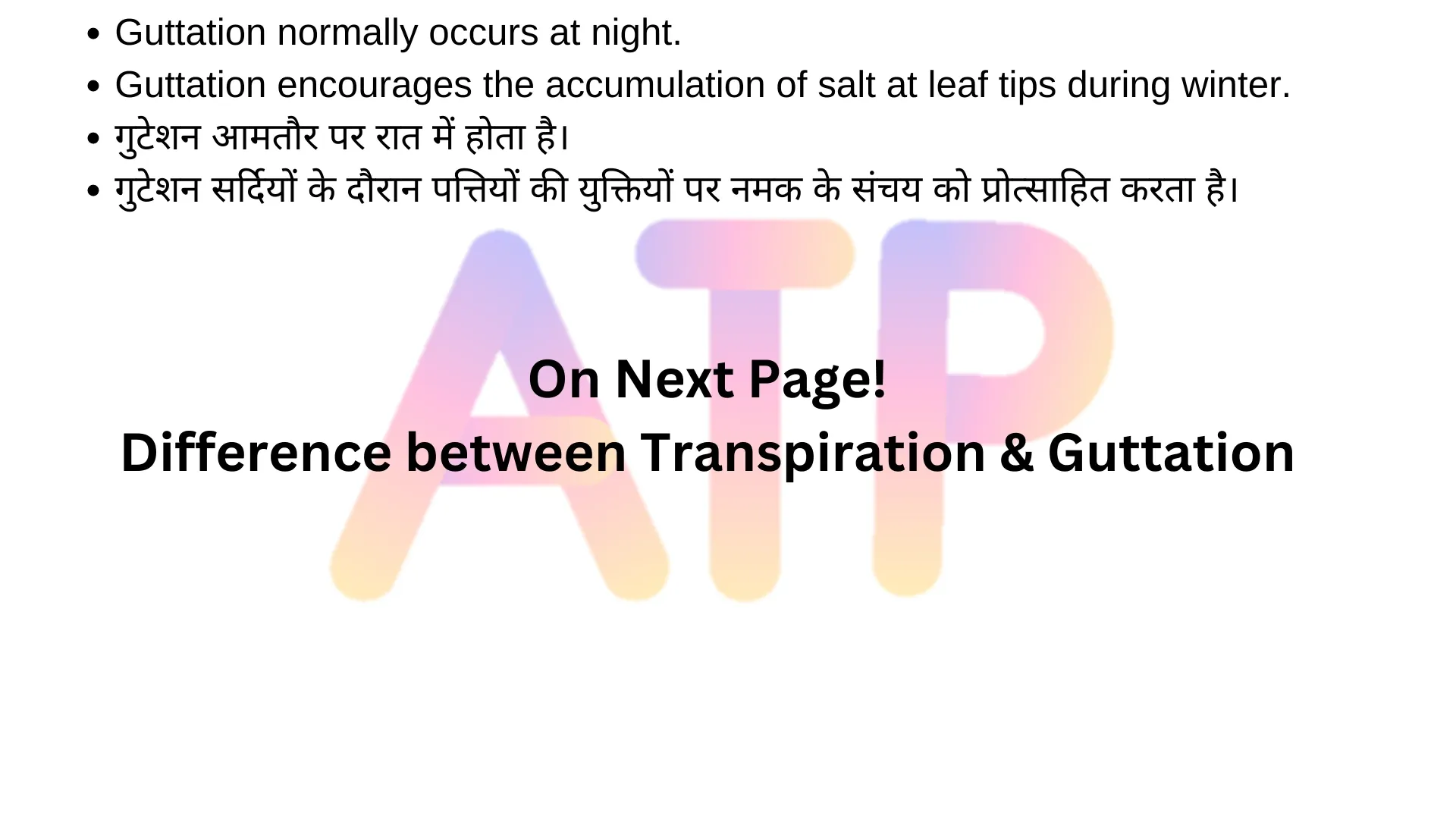Table of Contents
Transpiration
- Transpiration is a natural process.
- The loss of water in the form of vapour from the living aerial part of the plant is known as transpiration.
- Transpiration may be three types.
- वाष्पोत्सर्जन एक प्राकृतिक प्रक्रिया है।
- पौधे के जीवित वायवीय भाग से वाष्प के रूप में जल की हानि वाष्पोत्सर्जन कहलाती है।
- वाष्पोत्सर्जन तीन प्रकार का होता है
1. Stomatal transpiration
2. Cuticular Transpiration
जब जलवाष्प पौधे की उपत्वचा के माध्यम से वाष्पित होता है तो इसे क्यूटिकल
वाष्पोत्सर्जन कहते हैं।
वाष्पोत्सर्जन के द्वारा कुल हानि में से 09
-10% नुकसान रंध्रीय वाष्पोत्सर्जन द्वारा होता है।
3. Lenticular transpiration
1-2 % Loss by lenticular transpiration.
कभी-कभी लकड़ी के तने की लेंटिकुलर कोशिकाओं द्वारा जल की हानि या वाष्पोत्सर्जन होता है जिसे लेंटिकुलर वाष्पोत्सर्जन कहा जाता है।
इसके द्वारा जल की 1-2% हानि।
Related Posts
Significance of Transpiration
- Transpiration keeps the plant from being overheated.
- For some plant Transpiration help as a growth factor.
- Transpiration encourages to plant for absorption of water and as well as absorption of minerals. It's the main significance of transpiration.
- An increase in the contents of moisture in the atmosphere.
- वाष्पोत्सर्जन पौधे को ज़्यादा गरम होने से रोकता है।
- कुछ पौधों के लिए वाष्पोत्सर्जन वृद्धि कारक के रूप में मदद करता है।
- वाष्पोत्सर्जन पानी के अवशोषण और साथ ही खनिजों के अवशोषण के लिए पौधे को प्रोत्साहित करता है। यह वाष्पोत्सर्जन का मुख्य महत्व है।
- वाष्पोत्सर्जन के कारण वातावरण में नमी की मात्रा में वृद्धि होती हैं।
Factors Affecting the Transpiration.
A. Plant Factors:
i. Stomata:
The greater number of stomata = the grater is the rate of transpiration. Stomata is one of the main means of transpiration. Transpiration easily occurs through stomata.
रंध्रों की अधिक संख्या होने पर वाष्पोत्सर्जन की दर बाड़ जाती है।
रंध्र वाष्पोत्सर्जन के मुख्य कारकों में से एक है। रंध्रों द्वारा
वाष्पोत्सर्जन आसानी से हो जाता है।
ii. Leaf Structure:
पत्ती की मोटाई वाष्पोत्सर्जन की दर को रोकती है। परंतु पतली पत्ती वाष्पोत्सर्जन को रोकने में सक्षम नहीं होती हैं।
iii. Root system:
पौधे की जड़ प्रणाली घनी होने के कारण पानी का अवशोषण अधिक होता है जो की वाष्पोत्सर्जन की दर को प्रोत्साहित करता है।
iv Leaf orientation:
यदि पत्तियाँ आपतित प्रकाश (सूर्य से आने वाले प्रकाश) के लम्बवत् उन्मुख होती हैं तो ताप प्रभाव स्वाभाविक रूप से अधिकतम होगा। यदि किसी पौधे की पत्ती उत्तर और दक्षिण की ओर उन्मुख हों, तो उस पौधे को 'कैम्पस प्लांट्स' कहते हैं।
V. Fungal Infection:
कई प्रमाण के आधार पर ये कहा जा सकता हैं कि कवक रोग से प्रभावित ऊतक अधिक तीव्रता से वाष्पोत्सर्जन करते हैं। जो की वाष्पोत्सर्जन की दर को प्रोत्साहित करता है।
B. Environmental Factors:
i. Humidity:
आर्द्रता और वाष्पोत्सर्जन के बीच उत्क्रमणीय संबंध होता है।
ii. Temperature:
यह नमी, आर्द्रता, गर्मी जैसे अन्य पर्यावरणीय कारकों के प्रभाव के माध्यम से वाष्पोत्सर्जन पर अप्रत्यक्ष प्रभाव डालता है। तापमान अधिक होने पर आर्द्रता काम हो जाती हे जिस कारण वाष्पोत्सर्जन अधिक होता है।
iii. Wind:
हवा का वेग वाष्पोत्सर्जन को प्रभावित करता है यदि हवा का वेग अधिक होने पर वाष्पोत्सर्जन की दर बाड़ जाती हैं क्योंकि तेज हवाएं पौधे के चारो तरफ उपस्थित नामी को अपने साथ ले जाती हैं, और वायुमंडल की आद्रता काम हो जाती हे। जोकि वाष्पोत्सर्जन के होने का एक कारण है।
iv. Light:
यह एक महत्वपूर्ण कारक है क्योंकि रंध्र दिन के दौरान खुलते हैं और प्रकाश तापमान बढ़ाने में भी मदद करते हैं
v. Atmosphere pressure:
निम्न(कम) वायु दाब के कारण वायु के घनत्व में कमी आ जाती हैं जिससे वाष्पोत्सर्जन की दर को बढ़ावा मिलता है।
Guttation
- When the water of a plant Exudate through hydathode ( A structure present at the tips of veins of leaves) is called Guttation.
- The root pressure is the cause of guttation.
- जब पौधे का पानी हाइडेथोड (पत्तियों की शिराओं के सिरों पर मौजूद एक संरचना) के माध्यम से निकलता है, तो जल के इस स्राव इसे गुटेशन कहा जाता है।
- जड़ का दबाव गुटेशन का कारण है।
गुटेशन के लिए आवश्यक शर्तें -
(1) जल अवशोषण की दर में वृद्धि और वाष्पोत्सर्जन में कमी।
(2) गर्म मिट्टी और नम या ठंडा तापमान।
(3) गर्म दिन और ठंडी रात (जैसे सर्दियों के मौसम की स्थिति)।
- Guttation normally occurs at night.
- Guttation encourages the accumulation of salt at leaf tips during winter.
- गुटेशन आमतौर पर रात में होता है।
- गुटेशन सर्दियों के दौरान पत्तियों की युक्तियों पर नमक के संचय को प्रोत्साहित करता है।
Difference between Transpiration & Guttation.
Save this topic as a PDF Google Drive
If you see 'Generating Download link' then check your net Speed and refresh this page. Even then if you face any Problem contact with me, through bellow link
WhatsApp me!














